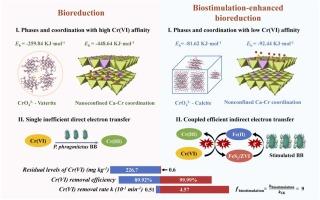铬矿加工残渣污染土壤的生物刺激增强微生物解毒:Cr(VI)关键宿主相转化和土壤微生物群转移的关键作用
IF 11.3
1区 环境科学与生态学
Q1 ENGINEERING, ENVIRONMENTAL
引用次数: 0
摘要
铬矿加工残渣污染土壤(COPR-soil)中Cr(VI)的持续缓慢释放对土壤和地下水构成重大威胁。尽管微生物还原被认为是修复Cr(VI)污染土壤的一种有效方法,但Cr(VI)在copr土壤中的还原效率和还原速率仍然很低,特别是嵌入在矿物(如vaterite, Ca/Al-Cr层状双氢氧化物(Ca/Al-Cr LDH))中的Cr(VI)仍然很低。本研究利用FeSx的强电子转移特性,开发了一种生物刺激增强的微生物解毒策略。对土壤中Cr(VI)的去除率达到99.9%,溶出Cr(VI)的还原率比微生物修复提高了9倍。FeSx半导体纳米颗粒紧密粘附在电活性细菌Pannonibacter phragmitetus BB (BB)表面,促进矿物-微生物相互作用,使蛋白质浓度提高35.8%,Cr(VI)耐受性提高23.0%。FeSx生物刺激可显著增强BB的生化溶解能力和电子穿梭电位,加速Cr(VI)宿主相的转化。Ca/Al-Cr LDH中的层间纳米限制Ca- cr配位转变为更容易接近的外部非限制结构,而钙石完全转变为方解石,转变程度提高了22%。这一转变使Cr(VI)的结合能力分别降低了68.6%和79.4%,有效地释放了矿物中的Cr(VI)。可溶性铁(III)作为一个关键的电子穿梭体出现,使电子通过铁(III)/铁(II)氧化还原循环从BB间接转移到Cr(VI)。此外,生物刺激提高了土壤肥力和稳定性,通过Cr(VI)外排和Fe-Fe载体复合物的细胞内易位,培养了微生物群落,提高了它们对环境胁迫的抵抗力。本研究为促进微生物有效修复copr土壤提供了一个有前景的策略。本文章由计算机程序翻译,如有差异,请以英文原文为准。

Insights into biostimulation-enhanced microbial detoxification of chromium ore processing residue-contaminated soil: The critical role of Cr(VI) key host-phase transformation and soil microbiota shifts
The continuous and slow release of Cr(VI) from chromium ore processing residue contaminated soil (COPR-soil) poses a substantial threat to soil and groundwater. Despite microbial reduction is considered as an effective approach for the remediation of Cr(VI)-contaminated soil, the efficiency and rate of Cr(VI) reduction in COPR-soil, especially Cr(VI) embedded in minerals (e.g., vaterite, Ca/Al-Cr layered double hydroxide (Ca/Al-Cr LDH)) remain low. Here, a biostimulation-enhanced microbial detoxification strategy was developed, utilizing the strong electron transfer properties of FeSx. The removal efficiency of Cr(VI) from COPR-soil reached 99.9 %, with a 9-fold increase in the reduction rate of dissolved Cr(VI) compared to microbial remediation. FeSx semiconductor nanoparticles adhered tightly to the surface of the electroactive bacterium Pannonibacter phragmitetus BB (BB), facilitating mineral-microbial interactions that increased protein concentration by 35.8 % and Cr(VI) tolerance by 23.0 %. Biostimulation with FeSx significantly enhanced the biochemical dissolution capacity and electron shuttle potential of BB, accelerating the transformation of Cr(VI) host-phases. Vaterite was completely converted to calcite with a 22 % increase in transformation degree, while the interlayer nanoconfined Ca-Cr coordination in Ca/Al-Cr LDH shifted to a more accessible outer nonconfined structure. This transformation reduced the Cr(VI) binding capacity by 68.6 % and 79.4 %, respectively, effectively releasing Cr(VI) from mineral. Soluble Fe(III) emerged as a critical electron shuttle, enabling indirect electron transfer from BB to Cr(VI) via the Fe(III)/Fe(II) redox cycle. Additionally, biostimulation enhanced soil fertility and stability, fostering microbial consortia with improved resistance to environmental stresses through Cr(VI) efflux and intracellular translocation of Fe-Fe carrier complexes. This study provides a promising strategy to promote effective microbial remediation of COPR-soil.
求助全文
通过发布文献求助,成功后即可免费获取论文全文。
去求助
来源期刊

Journal of Hazardous Materials
工程技术-工程:环境
CiteScore
25.40
自引率
5.90%
发文量
3059
审稿时长
58 days
期刊介绍:
The Journal of Hazardous Materials serves as a global platform for promoting cutting-edge research in the field of Environmental Science and Engineering. Our publication features a wide range of articles, including full-length research papers, review articles, and perspectives, with the aim of enhancing our understanding of the dangers and risks associated with various materials concerning public health and the environment. It is important to note that the term "environmental contaminants" refers specifically to substances that pose hazardous effects through contamination, while excluding those that do not have such impacts on the environment or human health. Moreover, we emphasize the distinction between wastes and hazardous materials in order to provide further clarity on the scope of the journal. We have a keen interest in exploring specific compounds and microbial agents that have adverse effects on the environment.
 求助内容:
求助内容: 应助结果提醒方式:
应助结果提醒方式:


